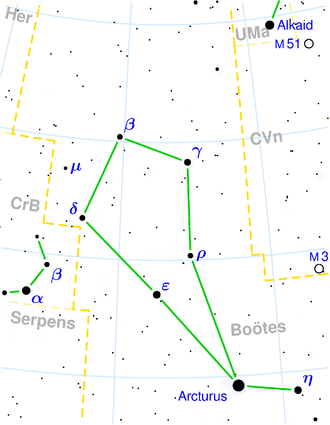NGC 5747
| Galaxy NGC 5747 |
|
|---|---|

|
|
| SDSS recording | |
| AladinLite | |
| Constellation | Bear keeper |
|
Position equinox : J2000.0 , epoch : J2000.0 |
|
| Right ascension | 14 h 44 m 20.8 s |
| declination | + 12 ° 07 ′ 47 ″ |
| Appearance | |
| Morphological type | Sa + Sb |
| Brightness (visual) | 13.6 mag |
| Brightness (B-band) | 14.4 mag |
| Angular expansion | 0.8 ′ × 0.8 ′ |
| Surface brightness | 13.0 mag / arcmin² |
| Physical data | |
| Redshift | 0.029684 ± 0.000033 |
| Radial velocity | (8899 ± 10) km / s |
|
Stroke distance v rad / H 0 |
(399 ± 28) · 10 6 ly (122.3 ± 8.6) Mpc |
| history | |
| discovery | Wilhelm Herschel |
| Discovery date | March 15, 1784 |
| Catalog names | |
| NGC 5747 • IC 4493 • UGC 9496 • PGC 52638 • CGCG 076-013 • MCG + 02-38-002 • IRAS 14419 + 1220 • GC 3988 • H III 48 • | |
NGC 5747 is a 13.6 mag bright spiral-shaped interacting double galaxy of the Hubble-type Sa + Sb in the constellation Bear Keeper and about 399 million light years from the Milky Way.
It was discovered on March 15, 1784 by Wilhelm Herschel with an 18.7-inch reflector telescope, who marked it with “eF ... an eF neb., It is S and required some time to look at it before it could be well seen ”. Due to an error in Herschel's position statement, Guillaume Bigourdan's observation on April 12, 1898 under IC 4493 led to an entry in the index catalog .
